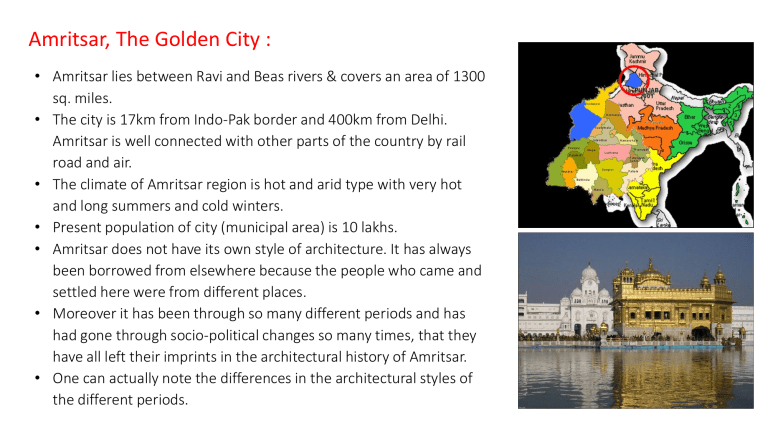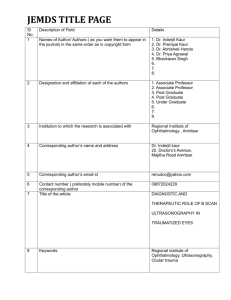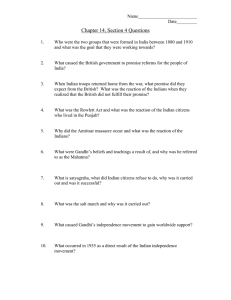
Amritsar, The Golden City : • Amritsar lies between Ravi and Beas rivers & covers an area of 1300 sq. miles. • The city is 17km from Indo-Pak border and 400km from Delhi. Amritsar is well connected with other parts of the country by rail road and air. • The climate of Amritsar region is hot and arid type with very hot and long summers and cold winters. • Present population of city (municipal area) is 10 lakhs. • Amritsar does not have its own style of architecture. It has always been borrowed from elsewhere because the people who came and settled here were from different places. • Moreover it has been through so many different periods and has had gone through socio-political changes so many times, that they have all left their imprints in the architectural history of Amritsar. • One can actually note the differences in the architectural styles of the different periods. • Earlier the architecture used to be influenced mainly by the Rajasthani style. With lots of jharokas, decorative motifs and carvings. • Later with the advent of Mughals, people started to use elements like the domes and the minars but these were slightly modified. • For example, the domes would be fluted. The British brought with them pediments, colonnaded verandas and entrance porches. • The modern style exploited new materials and also gave a new vocabulary to the architecture of Amritsar. A Visual of Jali & Intricate Carvings (from 1790s) • A stark contrast between the old and the new can be seen. • Earlier, the buildings would present a highly decorative façade with elements like jharokhas, recessed arches and chhatris breaking the façade. • Now building facades seem to play with massing in general. Solids and voids used in an interesting manner give a different dimension to the building. • New materials have also come. Reinforced concrete seems to have taken over the traditional brick buildings. Khalsa College (1898) Depicting Mughal Architectural Style like Onion Domes & Minartes. A Brief History : Foundation : In the first two hundred years of its history Amritsar was called Ramdaspur, because it was Guru Ramdas who under the able guidance of his predecessor, Guru Amar Das, wanted to found a township in a sacred spot where a tank had been dug in the year 1573 which is the present site of the umritsarovar. By 1577, the digging of the tank was complete. 1628, The township of Ramdaspur around the sarovar. Survival : After he left the city because of conflicts with Mughal administration, for more than a century the town did not grow any more : in fact it had to struggle for survival. Expansion : The Harniandir was constructed through a collective effort of all the leaders of the Khalsa. But a whole ring of forts with palaces, katras with their own markets and houses and some factories, and havelis with spacious gardens sprang up on all the sides of the town, which now came to be known as Amritsar. 1900, The settlement spilled outside the fort area. British settlements developed outside and away from the core. Consolidation : Under Maharaja Ranjeet Singh, the city got consolidated as well. In the third decade of the century, the Maharaja started constructing a double wall with moats around the city to improve its fortifications. Twelve gates, with bridges on the moats, were made. Twelve gates, with bridges on the moats, were made. In 1809, the Maharaja had constructed a fort outside the Lahori Gate, and named it Gobindgarh. Colonial Rule : Around the early 19th century, in 1849, the British took over the city. One of the early measures of the British administrators of Amritsar was to remove its fortifications. A new wall only a few feet thick was constructed, eaving only a few old gates intact. The Railway Station, the Town Hall, the Government School building, the District Courts, the Treasury, the Victoria Jubilee Hospital were all built in succession. Post Independence : After partition of the country in 1947 the entire scenario changed and the city, which commanded the central position, now became a border town 28 km away from the international boundary. After independence the city bore a great loss because of riots. 1947, Amritsar expanded in all directions. New settlements came along the GT Road and the Railway lines. 2000, the city becomes densely populated. The planned and the organic development has generated a complex growth pattern. Major events in the Post Independence period: Jallianwala Bagh Incident • On April 13th the day of baisakhi a public meeting was announced to be held a Jalianwala bagh maidan close to the golden temple premises to asset the people’s right to assemble and protest against the Rowlett act which had come into operation on march 21st 1919 and it had generated angst all over India. • But brigadier general dyer who had taken charge of Amritsar then decided to leash havoc on some 25000 men , women and children who had gathered there. • As the machine guns started raining bullets the dead piled upon the dead and wounded upon the wounded, since there was a single exit (narrow passage) resulted in a stampede. • Such a merciless massacre shocked the entire nation. • Today the place has become a pilgrimage of sorts, a symbol of Hindu Muslim unity, a hallowed spot where Indians shed their blood fighting for the freedom of their motherland. The protest was a peaceful one, and the gathering included pilgrims visiting the Golden Temple. The Jallianwalla Bagh memorial today. Effects of Partition • In 1849 when the British had taken over Amritsar from then to 1947 till partition Amritsar hardly registered much development in terms of socio cultural issues. • It had become a politically unstable state. After partition Amritsar could now look forward to a peaceful future. • Although it lost upon its communal harmony and witnessed arson, pillage and rapine in the beginning, it soon started recovering from its wounds. • Since it was the only connection to Lahore which now went to the other side it became an important border city. But the growth of the city got hampered because of the now existing physical barrier. • Although Amritsar lost upon a lot of things like fertile land and river and industries but it managed to strive forward to progress. Operation Blue Star • Operation Blue Star was the code name of an Indian military action which was carried out between 1&10 June, 1984, in order to capture the Sikh leader Jarnail Singh Bhindranwale and his followers hidden inside the buildings of Harmandir Sahib complex in Amritsar, Punjab. • Indira Gandhi and government of India declared president rule in Punjab and deployed 4 division of Army through out Punjab, in a desperate attempt to flush out Bhindranwale and his accomplice from Golden Temple complex. • Proper commando operations followed, commandos supported by infantry and tanks and machine guns attacked the holy place. Curfew was imposed in the city. • The operation itself led to the death of some 5000 people which included terrorists as innocent devotees who were trapped inside the complex. The city of Amritsar burnt for quite sometime in the wake of such a situation. • It led to civil war and riots not only in the city but all over the nation. It was a big attack on the temple but a bigger one on the sentiments of the people. Visuals from the Incident. Conclusion: • The History of Amritsar has been painful throughout the course of its evolution. • Several Incidents which are previously mentioned have been very influential in the shaping of the city. • The City has no particular architectural character but a mix of several styles such as Rajasthani Ornamentation, Mughal Style & influence of Western Style (during Colonial Rule). • The development of the city is in both organic & planned manner. • Further development has to be well thought by keeping the past incidents in mind and providing a particular character associated to the people of Amritsar. • This can be achieved through studying the lifestyle of the residents and incorporating them by usage of local materials, adapting of site responsive design strategies, façade treatment of the building & etc. • The huge influence of Golden Temple should not be forgotten. The temple complex itself provides a feeling of Relief to everyone. Victoria Jubilee Hospital ( One of the Biggest Hospital of Punjab during 1900s ) The Hospital was founded in the year 1891 and was renamed as Shri Guru Teg Bahadur Hospital in the year 1975. Currently the place is being used as Food plaza under the name ‘Urban Haat’ to boost the Toursim Industry. Khalsa College, Amritsar: • Khalsa College was built as an educational institute during the British Raj in India when Sikh scholars thought about providing higher education to Sikhs and Punjabis within Punjab. • Its architectural design was created by Ram Singh, a famous architect who also designed one of the Places in England. • Its building was completed in 1911–12. Its architectural features are mix of British, Mughal and Sikh architect. • The main building is considered a gem of the Indo - Sarcenic style, which is strongly influenced by traditional Indian and Mughal schools of architecture. • The foundation stone was laid on 5 March 1892, with the first classes starting in 1893. Gobindgarh Fort, Amritsar • Gobindgarh Fort is a historic military fort located in the center of the city of Amritsar in the Indian state of Punjab. • The Fort was until recently occupied by the army but was opened to the public from 10 February 2017. • Today the fort is being developed as a museum and theme park, as a repository of Punjab’s history. • It was originally built by Dhillon Jat Misldar (militia chief) Gujjar Singh Banghi of Bhangi Misl, the local chieftain in the 18th century. • Gobindgarh was conquered and enhanced in the early 19th century by Sandhawalia Jat ruler Maharaja Ranjit Singh who renamed it after the 10th Sikh guru, Guru Gobind Singh.





